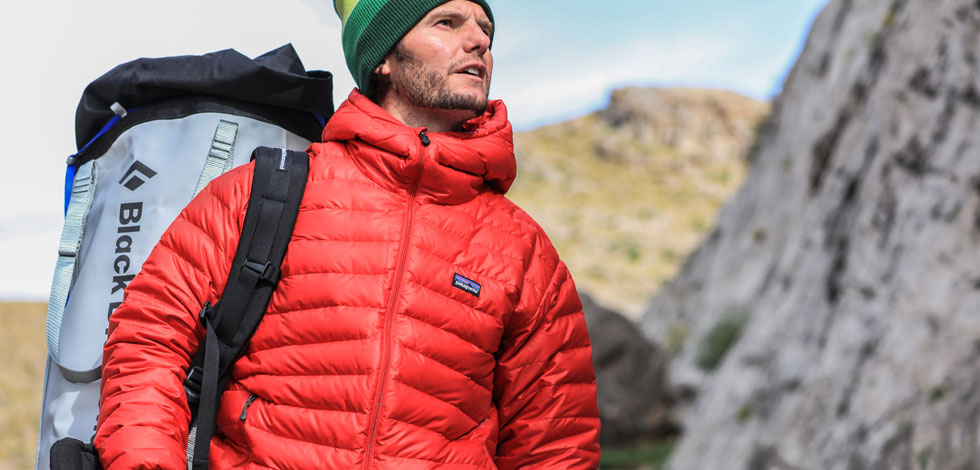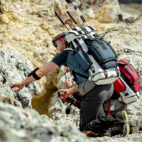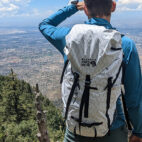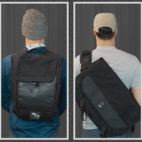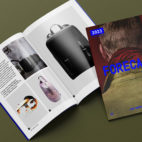A Beginner’s Guide to Climbing Packs
Keen to get into climbing but not sure where to start in the carry department? Guest contributor and climbing enthusiast Matthew “Blue” Taylor has you well covered with this awesome beginner’s guide to climbing packs…
Types of Climbing Packs
Crag Pack
If you’re just getting into rock climbing outside (where the air is clear and the holds are real), you’ll probably be best served by a backpacking pack or, if you know you’re serious, a crag pack. The basic climbing pack, sometimes called a crag pack, is designed specifically to carry climbing gear to the crag: quickdraws, rope, climbing shoes, snacks, water, layers for variable weather conditions. This bulky gear needs to be carried up potentially steep and scrabbly terrain and then be easily accessible at the destined crag. The pack will likely get scraped against rocks and trees on the way. Since the approach or hike to the crag or cliff can be rough, climbing packs are usually made out of Dyneema, ripstop nylon, tarpaulin, or Cordura. Durability and suspension might be sacrificed for a lighter pack in alpine or mountaineering situations, but for a crag pack you want something that can take daily cragging abuse. Crag packs frequently have multiple handles to easily move them from route to route on the same crag or wall. Most crag packs will be about 35 liters to 50 liters and they tend to come in many different opening or loading styles detailed in a section below. These different loading styles provide easy access to all of the gear.
Rope Bags
Rope bags are tarps turned into packs to carry your most precious lifeline and keep it clean. Over time dirt gets inside the rope fibers, getting the belayer’s hands dirty and creating more wear and grime on all of the hardware the rope passes through, but a rope tarp or bag can help minimize this. Rope bags can also make it easier to keep the rope organized and avoid knots forming without having to carefully coil it after each use. If a crag pack is big enough, the rope and rope bag can be carried inside of it. Some climbers who pack light will use a rope bag such as the Bolsa by Petzl, instead of a crag pack to carry everything. A rope bag can also be used to keep your climbing shoes off the dirt when not being used for climbing, such as in the picture of the Black Diamond Super Chute rope bag.
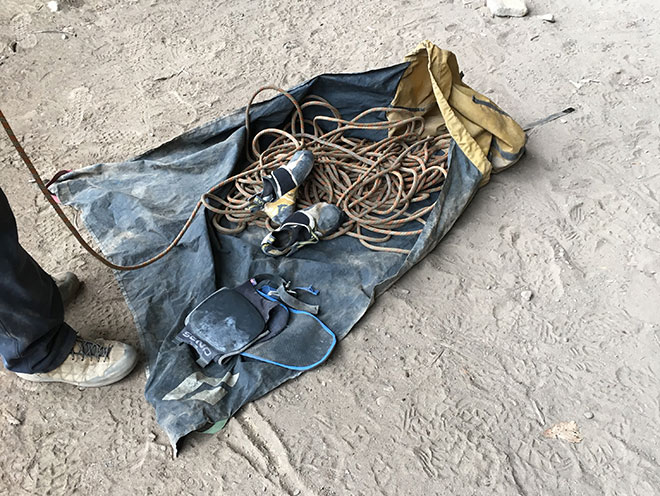
Alpine or Mountaineering Packs
Alpine packs are designed for more variety of terrain including rock, snow, and ice. They usually have bungee cords or loops on the outside to attach ice climbing tools and crampons without cutting the pack (or the climber wearing the pack). Alpine packs tend to be top loading and of lighter fabrics to shave weight and keep things as simple and streamlined as possible while still carrying everything. They also tend to have simpler closing systems that can be used while wearing gloves. For adventures that are one day or less a good size is 35 to 50 liters.
One of the best companies in the business is Hyperlite Mountain Gear. For just climbing multi-pitch rock faces the 2400 Porter is a great option. If you want to add ice climbing into the mix the 2400 Ice Pack is a great option. Arc’teryx, a company which started by making cutting-edge climbing harnesses, also makes great alpine packs. A versatile option is the Alpha FL 45.
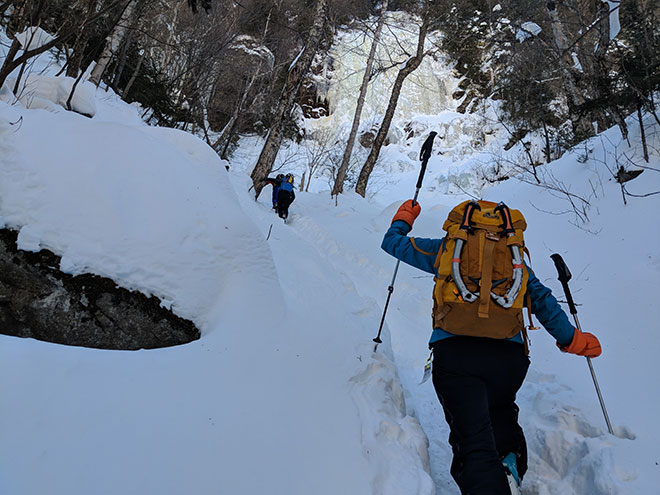
Rima wearing an older version of the Gregory Alpinista 45 for mountaineering. Notice the loops for carrying ice tools.
Overnight or Extended Alpine and Mountaineering
For being out in the wilderness then something at least 45 liters or bigger, such as the Black Diamond Mission 75 or the Hyperlite Mountain Gear 4400 Ice Pack make great options. These are built for packing the kitchen sink and hauling it up long approaches. Speaking of which…
Haul Bags
The well-named haul bag is meant to be pulled up a wall behind you on longer climbs after. Since they are pulled up by the rope across a rock face, they are engineered to be streamlined and extremely durable. The two most widely used fabrics are urethane and vinyl coated nylon. Most haul bags are shaped like big buckets with straps on top. A great lineup of haul bags are made by Metolius. One of the smaller ones such as the Sentinel or Quarter Dome (right) can double up as a crag pack. This is a good choice if you want a crag pack that is burly enough to handle a zombie apocalypse, nuclear holocaust, alien invasion, a severe shortage of taco trucks, or if you just want to carry your lunch through packs of starving mountain bikers.
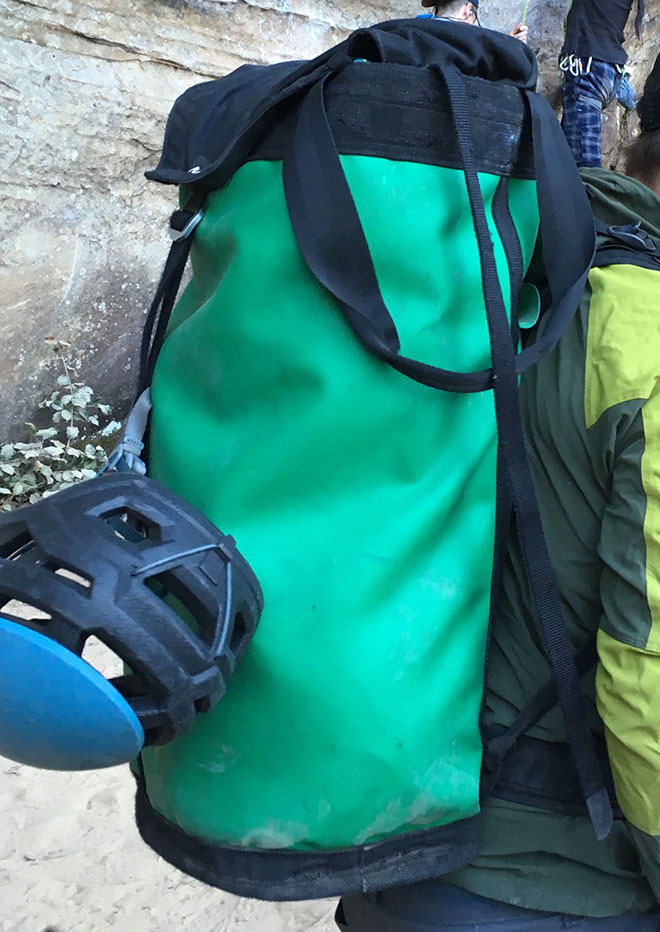
Summit Packs
Summit packs are designed to be small enough to be worn while climbing without hindering movement. This is the smallest category of climbing packs, 10 to 20 liters. Since most of the actual climbing protection including quickdraws, slings, cams, and nuts will be on the climber’s harness loops, the summit pack is for carrying water, snacks, and an extra layer or two of storm protection. Summit packs might be stored inside of a bigger pack during the approach to the base of a climb.
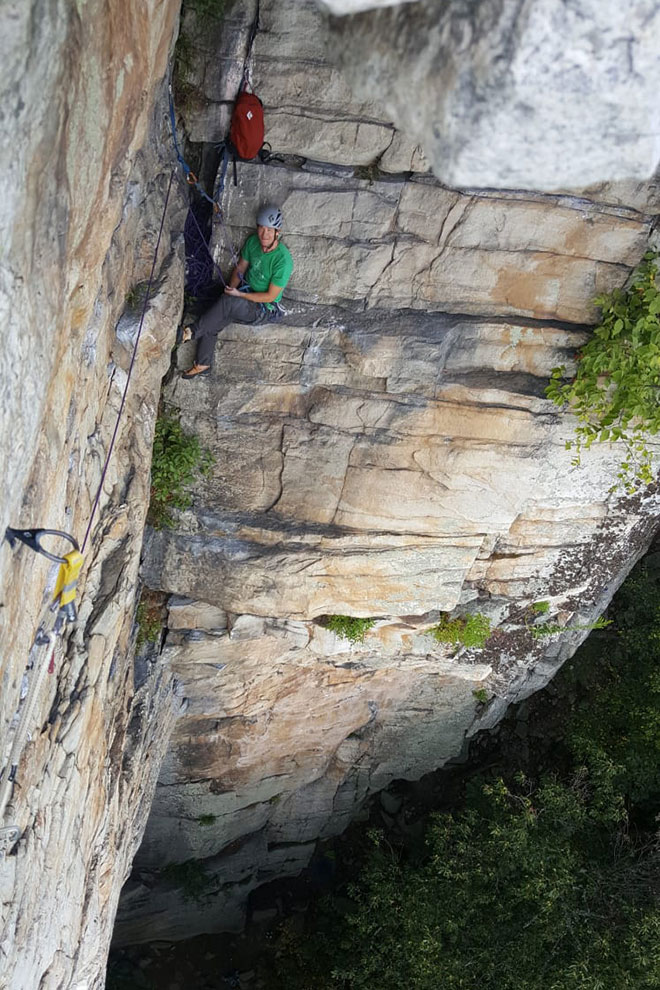
Dan Cooper using his red Black Diamond Bullet 16 while climbing in the Gunks (left). Cooper takes a reflective moment out of his busy life as a family man, coordinator of outdoor experiences for NYC students, and starting a microbrewery.
Gym Bags
This relatively new category accommodates climbers who go to the gym after work. These tend to be smaller and might be a simple messenger-style bag such as the Gym 30 by Black Diamond or a commuter backpack like the Seon Shuttle by Mammut with compartments to keep your gym climbing gear and your office gear separate.
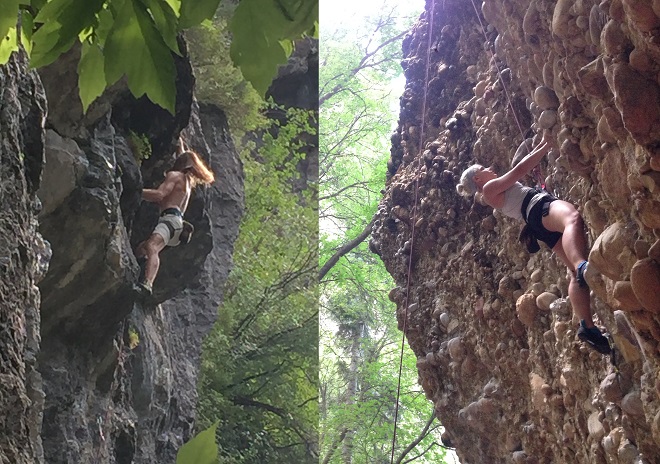
Outside in Utah getting some vitamin D last summer. The author in American Fork Canyon (left) and Liz on a route in Maple Canyon (above).
Loading and Opening Styles
Some climbing packs feature innovative engineering.
Top Loading
The most similar to traditional backpacking packs. The downside to top loading is the opening might not be as big and you might have to dig through your stuff or empty it all out to get what you need. The upside is they are the easiest to cram your stuff back into and they tend to be the simplest and lightest designs.
Burrito
This style opens up for complete access to all your gear. Some burrito styles are padded, which means they can double up as a nice spot to rest between climbs or share with friends like a mini couch or sleeping pad. Having a small bag to put inside the pack for essentials can be helpful so that they don’t get lost when it’s spread out.
- Spot Pad by Organic Climbing
- Pipe Dream by Black Diamond
Duffle
Useful to see most of your gear though not as open as burrito or suitcase-style bags.
- Crag Station by Metolius
- Stone Duffel 42 by Black Diamond (pictured below)
Clamshell or Suitcase
Similar to travel luggage, this makes it easy to access all of your gear at the crag.
- Flight by DMM
Hybrid Opening Styles
Many packs open in more than one way. This is useful for easy packing at home or in the car, and easy access in different situations.
- Cragsmith by Patagonia – both top and duffel
- Gravity by Grivel – both top and duffel
- Creek 50 Pack by Black Diamond is mainly a top loader but also has a big side zipper similar to the duffel style
- Neon Gear 45 by Mammut (pictured right and below) opens similarly to the Cragsmith
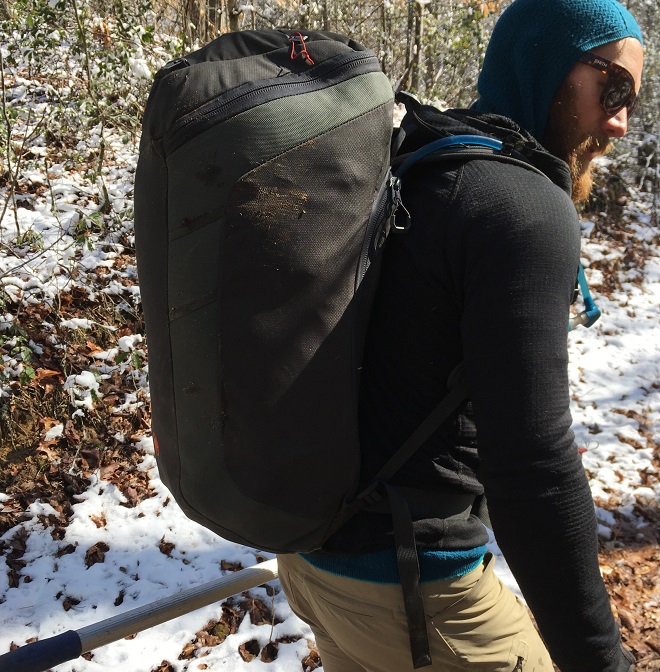
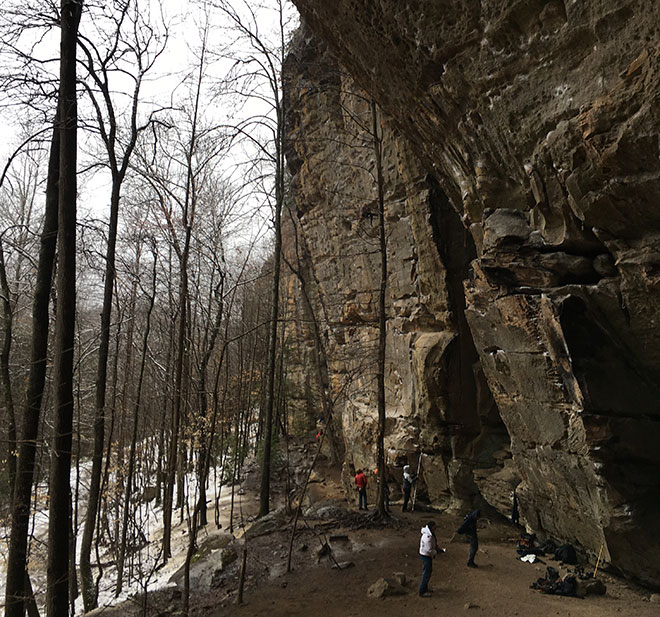
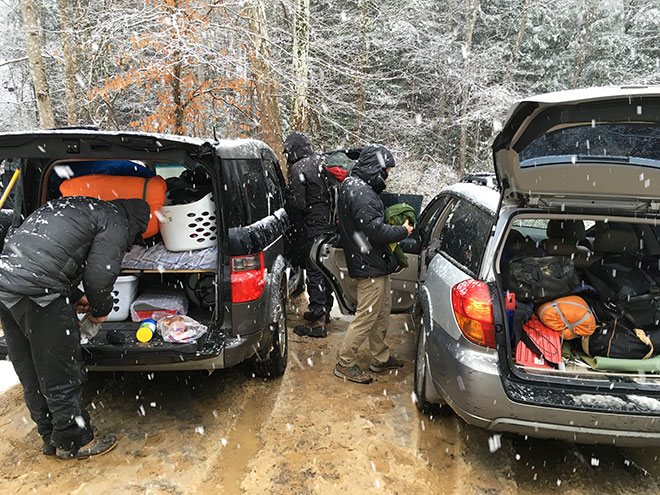
Rock climbing in the colder months although not as popular as in the summer has its advantages. There are less crowds, less likelihood of greasing off rock holds from sweaty palms, and overhanging walls can provide shelter to climb on dry rock. Warm layers and a spot of coffee or tea also helps.
Figuring the Correct Size
Torso length is more important than height. Measure the distance between the C7 vertebrae (generally the one that sticks out the most at the base of our necks) and the top of your hip bones (called the iliac crest). Put your hands on your waist with your thumbs on the top of your hip bones in back. Have a friend measure the length of your spine from between your thumbs to your C7 vertebrae. Some packs – such as the Patagonia Cragsmith – come in different torso lengths. Most climbing or outdoor stores will encourage customers to try on several sizes and styles of packs. Put some weight in while testing it out. An easy way to do this is to use the store’s climbing ropes that are for sale. Just make sure the store reps don’t think you are running off with their gear. Some stores have a device for measuring your ideal pack size (similar to a shoe size measuring device). As with hiking packs, the weight of the pack should rest on your hips, as opposed to your shoulders.
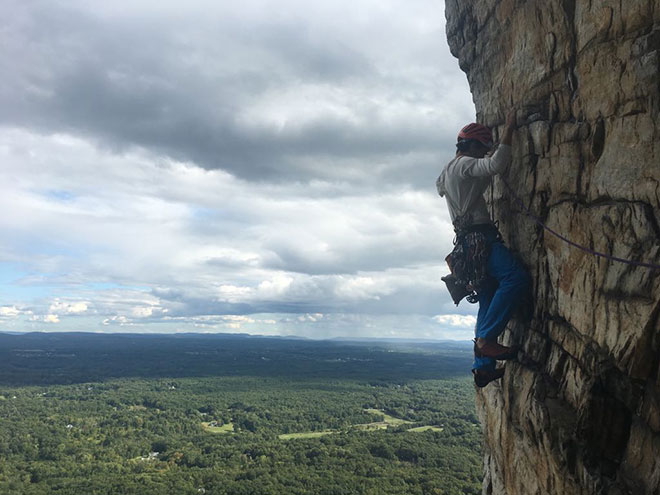
Fernando Molina, a mountain guide in Argentina and a rope specialist for cell phone towers and construction sites, using his free time to enjoy the Gunks. (Photo by Dan Cooper).
Recommendations
Best Overall Pick
The Creek 50 by Black Diamond is a great pack for both sport and traditional climbing. A climbing retailer once told me he sells ten of them to any other climbing bag. I’m not sure if he gets a kickback from BD, but I did notice several climbers on my last trip in the Red River Gorge with this pack. It has ample room, a drawstring top and side zipper that combine into one gaping opening, durable waterproof fabric and the bottom panel helps it sit on the ground well.
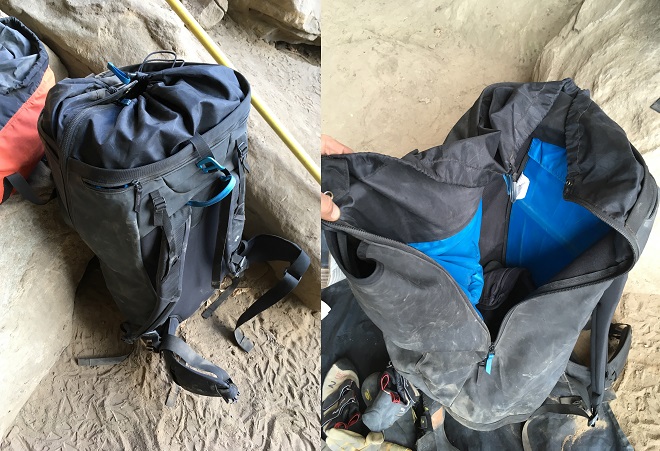

Jeff Ashley and Brendan Leader, both using the Creek 50, gave us some helpful beta (climbing parlance for information or advice) on the route we were working. Jeff said he would keep the sales tag on his pack to help distinguish it since it is such a popular bag.
Streamlined Simplicity
Black Diamond Stone Duffel 42. If you are just trying out the sport and going outside you will likely spend most of your time sport climbing or single pitch trad climbing. As of this writing it retails for an affordable US$85.95. I have also seen folks use it at the airport instead of wheeled luggage.
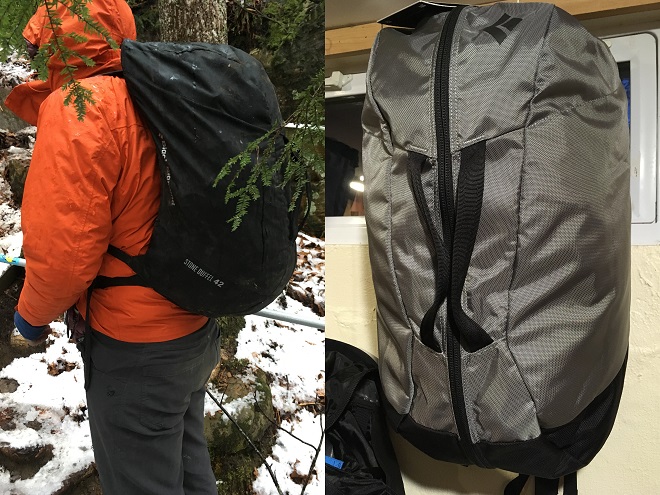
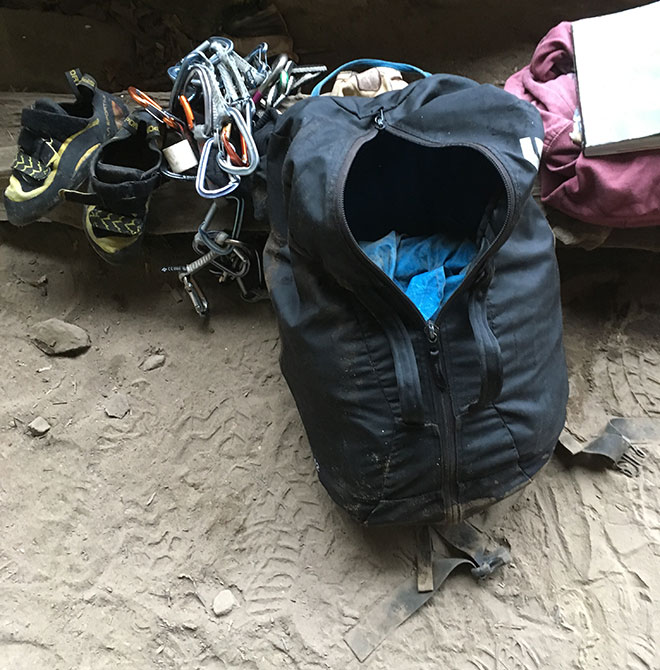
Supreme Toughness & Durability
The Metolius Sentinel or Quarter Dome Haul Bag could be used as a crag pack burly enough to survive a zombie-nuclear apocalypse as well as whatever nature throws at us. It’ll also be a great haul bag if you get into big wall climbing.
Cragging Comfort
The Spot by Organic Climbing is all about easily accessing all of your gear at the crag and unfolding to be a comfortable place to relax on when you are not belaying or climbing. I have The Spot and love it as do many of my friends. I have come off a climb more than once to see a friend or two lounging on it. I also love that you can choose the accent colors if you order through Organic Climbing’s website. They are a small boutique company based in Pennsylvania, USA. They are small and personal enough that the owner and founder personally responded to my email when I ordered mine.
Doubles as Airline Carry-On
The Flight by DMM is streamlined on the outside, padded, has decent suspension and has a shape and size that maximizes what many airlines allow as overhead bin carry-on luggage. The Rocker by Grivel is similar.
Dirt Cheap
If you really need to pay attention to your budget but need something to use until you can purchase something better then buying a used pack at a gear swap, second-hand store, or online from sites like eBay, Craig’s List, Amazon, or KSL can save a lot. Even though I now have a couple of newer climbing packs that I love, I still occasionally use my second-hand Evening Star hiking pack from REI which was my first pack (pictured right).
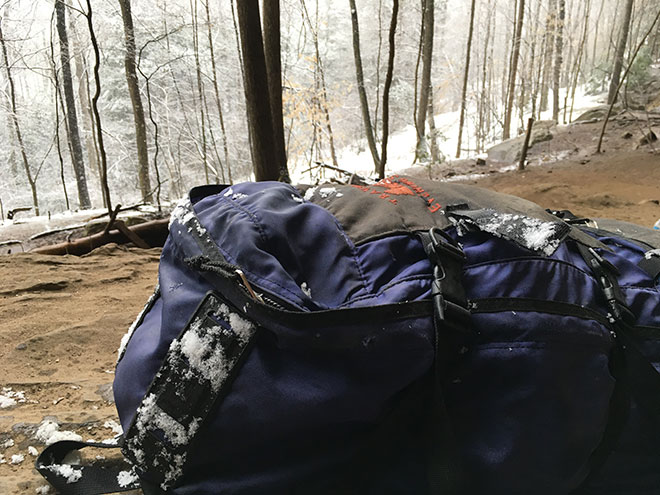
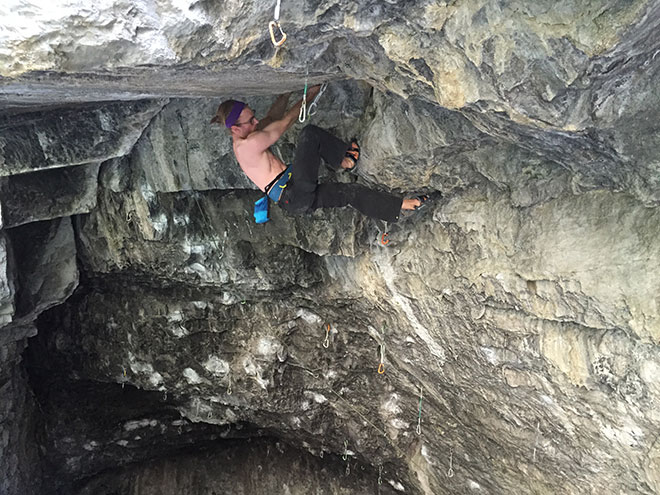
Some overhung walls can provide a shady spot to climb on a hot summer day. The author trying out the moves on the route Melting, in Hell Cave, American Fork Canyon, Utah.





 Carry Awards
Carry Awards Insights
Insights Liking
Liking Projects
Projects Interviews
Interviews
